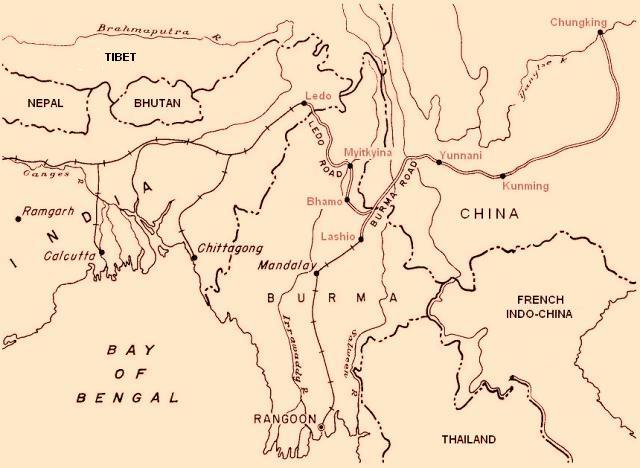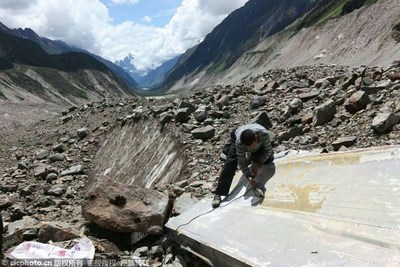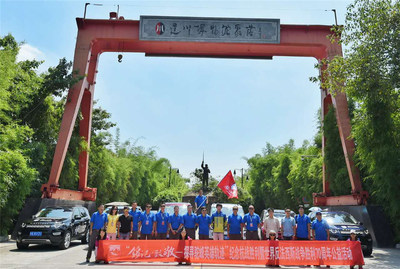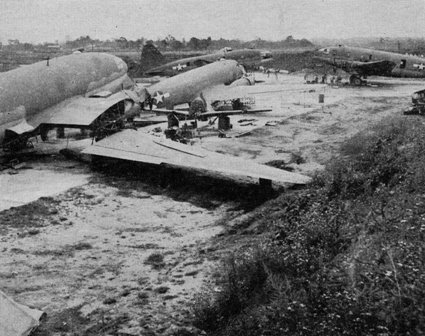
“The world’s first strategic airlift,” the U.S. Air Force calls it.
Special Frontier Force Reviews Hump Airlift Operation 1942 – 1945


Excerpt: On behalf of Special Frontier Force, I review the “HUMP” airlift operation during the course of The Pacific War 1941 – 1945. The legacy of the “HUMP” cargo flight service operation endures to this day as the same US transport aircraft shaped the beginning of the Tibetan Resistance Movement in 1948-49. Some Hump flights delivered arms and ammunition to Tibet but Tibet failed to use the opportunity to formulate diplomatic and military alliance with the US. Special Frontier Force which represents the Tibetan Resistance Movement acquired some of the US aircraft that provided cargo flights flying the “hump” route. I have flown in these aircraft in the Indian sector of The China-Burma-India Theater of World War II and visited various airfields in Assam, northeast India built by US forces who arrived in response to Japan’s successful military campaign in Southeast Asia during 1941- 42. In my analysis, the Supreme Ruler of Tibet and his regents failed to seize the great opportunity to fully prepare Tibet from the threat of Chinese Expansionism.

About 80 years ago (April 04, to June 22, 1944) during the Battles of Kohima, and Imphal, Allied troops, mainly Indians, drove back the invading Japanese forces from India’s borders. “Hump” airlift operation was primarily intended to support Chiang Kai-shek’s Nationalist China at their capital Chungking. The Pacific War ended on August 14, 1945, but the “hump” cargo flights continued until September or November 1945 as Nationalist China fought a bitter civil war with Red Army supported by China’s Communist Party. However as US relations with Nationalist China cooled off, US Special Representative to China placed an embargo on further shipment of US arms to Nationalist China during August 1946.
I am sharing an article titled “The Hump was the Deadliest Cargo Flight in History” authored by David Axe. This author mostly refers to findings from Francis B Pike’s book titled ‘HIROHITO’S WAR – THE PACIFIC WAR 1941 – 1945’. To understand the “hump” airlift operation, it will be necessary to know about ‘Burma Road’, a road extending about 700 miles from Kunming, Yunnan Province., S.China, to Lashio, a railhead in Burma. It was built-in 1937- 38 over mountainous terrain by the Chinese. It achieved its greatest importance during World War II, when Japan controlled the East Asian coast and the road served as a vital artery for the transport of Allied military supplies to Chinese forces fighting Japanese. On December 25, 1941, Japan captured Hong Kong. Japanese forces based in Thailand invaded Burma on February 08, 1942. Japanese captured Rangoon on March 08, and Allied Forces lost control over Lashio on April 30, 1942, which closed the Burma Road ending overland supply to Nationalist China. By the end of May 1942, the Japanese held most of Burma and the Allies were left with no supply route to engage Japan on Chinese territory. The solution was found in an air route from Assam in India’s Northeast to Kunming, and various airports in Yunnan Province, Southwest China, the “Dangerous” hump route along the southern edge of Himalaya mountain range. The “hump” route covered a distance of about 525 miles passing over the mountainous region of far north Burma and Western China. The height of mountains in Burma, North-South spur of the main East-West Himalaya mountain range, varied from 16,000 to 12,000 feet. In March 1942, the China National Aviation Corporation (CNAC) began freight service over the “hump” and the US began a transport program in April 1942. In 1944 Japan advanced toward Assam to cut Allied supply lines or capture the airfields at the Western end of the “hump.” Japan’s attack on Assam (March to July 1944) was defeated with help from transport planes withdrawn from the “hump.”
US Army’s Air Transport Command using elements of the 10th Air Force began flying cargo over the “hump” using Dakota C- 47 Skytrains, C – 46 Commandos which gradually expanded into first sustained, long-range, 24-hour around the clock, all-weather aerial cargo flight operation in history. Initially, the “hump” operation involved about 27 planes and about 1,100 pilots and support personnel. By December 1943, cargo planes carried tons of supplies equivalent to the tonnage carried along the Burma Road at the peak of its overland supply operation. In the fall of 1944, Consolidated C – 87s, Douglas C – 54 four engine aircraft were pressed into cargo flight service. In August 1945, the “hump” operation involved 622 aircraft, 34,000 military personnel, and about 47,000 civilian employees. During the course of the “hump” operation, the United States lost 509 downed aircraft identified, and 81 aircraft were listed as missing. The loss of aircraft was mostly contributed by weather-related problems and a few due to enemy action. The United States lost 1,314 crew members killed in action, and 1,171 personnel survived bailouts. US officials reported 345 as Missing in Action (MIA). The search and accounting of MIA have mostly concluded by 1950s and in recent times, there has been a renewed demand to continue search operations following the discovery of cargo plane crash sites in the jungles of Northern Burma along the “hump” flight routes.
At Special Frontier Force I derive consolation from the fact that the legacy of the “HUMP” operation endures. The US transport planes played a role in shaping the Tibetan Resistance Movement from its early beginning during 1948-49 as United States, India, and Tibet recognized the security threats posed by growing Communist military power in mainland China.

Rudra Narasimham Rebbapragada
Ann Arbor, MI 48104-4162, USA
The Spirits of Special Frontier Force

THE HUMP WAS ONE OF THE DEADLIEST CARGO FLIGHTS IN HISTORY

A third of Allied aircrews died hauling supplies to China in World War II
by DAVID AXE
Few people appreciate it today, but for a period of more than three years during World War II, a force of mostly American airmen undertook one of history’s most complex — and deadliest — logistical operations, flying thousands of tons of supplies from India over the Himalayas into China in rickety, under-powered cargo planes.
“The world’s first strategic airlift,” the U.S. Air Force calls it.
These flights over “the Hump” were indispensable to China’s war effort against the Japanese, and thus a major factor in the Allies’ ultimate victory.
But at a tremendous cost. No fewer than 700 Allied planes crashed or got shot down and 1,200 airmen died. “Every 340 tons delivered cost the life of a pilot,” historian Francis Pike writes in his exhaustive new history.
Hirohito’s War: The Pacific War, 1941–1945.
Within a few months after bombing Pearl Harbor in December 1941, the armies of Imperial Japan occupied a swath of Asia extending from China and Korea south into Burma and what is now Indonesia, eastward all the way to isolated islands in the middle of the Pacific.
Tokyo’s march seemed inexorable. And Japan’s expansion might have been much, much more aggressive if not for the valiant and bloody resistance that Chinese Generalissimo Chiang Kai-shek and his fighters offered up in the portions of their country the Japanese did not fully control.
Chiang’s soldiers tied up no fewer than 1.5 million of Tokyo’s own troops, Pike asserts in his dense new tome, which at nearly a thousand pages defies conventional review. But the Chinese were strapped for weapons, ammo, and supplies. The Allies — and America, in particular — were desperate to keep
China fighting and, by extension, keep Japan bogged down.
As Pike explains, prior to May 1942 the Allies maintained a land route from India through Burma into China. But Tokyo’s conquest of Burma shifted the burden of supplying Chiang’s forces to a contingent of initially just 25 planes — a mix of Douglas DC-3s, C-39s, C-47s and C-53s that was wholly inadequate for the mission’s demands.
“When fully loaded, Douglas DC-3s could not climb high enough to clear all the peaks and were forced to weave a perilous path through the mountains, a task that was virtually impossible when the treacherous Himalayan weather closed in,” Pike writes.
Turbulence could force a plane to drop thousands of feet in mere seconds.
“Flight operations were a pilot’s nightmare,” according to the Air Force.
Planes crashed. Japanese fighters shot down others. In April 1943 the U.S. Army Air Corps rushed the bigger and more powerful Curtis-Wright C-46 into production to help out with Hump ops, but the new plane’s engines had a tendency to ice up. “The bugs were worked out over the Hump,” Pike quotes one pilot as explaining.


At the top — a C-46 over the Hump. At right — view from over the Hump. Photo by Gifford Bull
By the end of 1943, the Allies’ Air Transport Command had 142 types of transport and five crews for each plane. ATC eventually swelled to 700 planes supported by 84,000 military personnel flying 1,000 miles round trip delivering up to 10,000 tons of supplies a month, “with a plane crossing the Hump every two minutes,” according to Pike.
Granted, the airplanes and aircrews were just part of what was, in fact, an unbelievably vast effort, also involving cargo ships that deposited supplies in Calcutta and trains that hauled the material to the airfields — not to mention roughly two million Indian and Chinese laborers who built the airstrips in their respective countries by hand.
But the aircrews arguably suffered the most of all the people involved in the Hump operation. “There was an approximately one in three chance of being killed,” Pike writes — one of the worst wartime survival rates ever. Of the 700 planes (US official estimate 590 planes) that went down trying to cross the Hump between 1942 and 1945, some 500 (US official estimate 81 missing aircraft and 509 downed planes fully identified) remain missing more than 70 years later.
Published on Jun 18. All rights reserved by the author.











Special Frontier Force Reviews the Discovery of wreckage of a Hump Airlift Operation Transport Plane

Special Frontier Force shares interest in the discovery of wreckage of a Hump Transport Plane that crashed in Tibet 80 years ago. In a previous post on this subject, I have shared the maps of Hump Flight routes and majority of crashes occurred either in Burma or Southwest China, and not in Tibet.
Wreckage of a Hump Transport Plane That Crashed in Tibet 80 Years Ago Now En Route to the Jianchuan Museum in Chengdu, China

On August 5, Xinhua News Agency photo center photographer embedded into the search party took a group photo with volunteers in the 4,100-meter-high unpopulated area
On August 5, volunteers collected wreckage in the 4,200-meter-high area.

CHENGDU, China, Aug. 13, 2015 /PRNewswire/ — Wreckage of an air freighter that was navigating over the Hump, the name given by Allied World War II pilots to the eastern part of the Himalayas due to the difficult challenge the mountain range posed to the pilots, when it crashed into a glacier 70 years ago and where its debris have since remained, was moved from Bomi County, Tibet, to Chengdu, Sichuan province on August 11. The valuable historical relics which are an important part of the story of Sino-US cooperation during WWII will be sent to China’s largest private museum, Jianchuan Museum.
The remains belong to the United States army’s Consolidated C-87 Liberator Express, serial 41-24688, which crashed in the winter of 1943. The C-87 plane and the remains of five U.S. pilots were discovered in the area, 4,100 meters above sea level, by local hunter Luo Song in September 1993. China and the U.S. later confirmed that the remains belonged to an airplane which had crashed at that time. The two countries held a transfer of remains ceremony at which then U.S. President Bill Clinton paid final respects to the deceased. However, the majority of the remains of the plane were left on the glacier.
Jianchuan Museum security director Choenyi Choedak took part in the search. He told reporters that the search team found many remains including three pairs of army boots, including a pair of thigh-high boots, two pairs of hunting boots and one pair of low boots.
“Those boots are the same ones that I saw in the 1990s,” Luo Song, an inhabitant of Zhongbei Village, Yigong, who guided the search team to the glacier and one of five local people who first discovered the crashed remains in 1990, said.
Beset by the limitations in terms of transport, the search team could only move about 50 pieces of the valuable wreckage, including a 4.5-meter-long and 2-meter-wide wing with an engraved white five-pointed star, as well as the dashboard, the engine and cabin parts. A reporter described seeing words and acronyms, among them, “Chicago,” “USA,” “FBE-18” and “PAT” on some parts of what was collected.
Yang Jianchao, head of the search team and deputy director of Jianchuan Museum, said that it was especially difficult to climb onto the glacier as there are no roads or bridges. The members of the search team had to build makeshift roads and bridges while climbing and then carried the remains on their backs and descended the mountain with the help of 41 Tibetan porters.
The route over the Hump was established during the World War II and served as an “aerial lifeline” to transport strategic supplies from Allied positions further west into China. It is the longest-running, hardest and most costly airborne route in the history of wartime aviation. The Hump pilots transported about 850,000 tons of strategic supplies and roughly 1,500 American planes crashed along the route in southwest China.
“The route can be clearly seen from the light reflected by the wreckage of our companions’ crashed planes on a clear day and we call the valley with the scattered wreckage of airplanes ‘Aluminum Valley’, a name as cold as the metal,” citing The Time’s descriptions of the Hump during World War II.
Yang, the museum deputy director, explained that during the war, thousands of aircraft flying the Hump crashed, but few of them have ever been found. It is the first time that such a considerable collection of remains is being brought together in a museum.
The search was initially planned six years ago. In 2009, Jianchuan Museum curator Fan Jianquan, learned from his comrade-in-arms that the wreckage of a U.S. transport airplane along the WWII Hump route remained in the depopulated zone in Nyingchi Prefecture in Tibet. He immediately developed a strong desire to find and bring in what he knew had to be a behemoth of a plane to Chengdu.
“Six years ago I told myself that I must take the remains to Chengdu, but I was unable to do what I had hoped to do as conducting a search over such uninhabitable terrain combined with the need to properly handle and preserve such cultural relics needed the assistance of professionals,” Fan elaborated. “My wish finally came true this year, after years of elaborate planning.”
One of the halls in the museum, the Flying Squad Hall, houses many U.S. army relics from the World War II period, in commemoration of the aid provided by the U.S. Air Force to China during the war.
“I felt all the hard work had been more than worthwhile when I saw the wreckage,” said Hu Zhiyang, a volunteer who was nearly hit by a rock that had fallen off the side of the mountain during the climb. Despite the elaborate planning, the actual search proved far more difficult than expected.
Another team leader Jiang Fan said that he felt he could vividly imagine the ordeal of the pilots when he first came upon the wreckage. “These pilots were the very the best flyers of that era. It is heart rendering to think that they travelled so far from their homelands to fight for the world peace,” Jiang said.
Search team member Ni Jian said that he felt that it was a worthy search, although the expedition was exhausting and he suffered badly from altitude sickness. Kuailu Investment, where Ni works, invested over 300 million yuan (approx. US$50 million) in making a film to be named The Bombing, depicting the horror that can be inflicted by military aggression by showing the ruthless bombing of Chongqing by the Japanese army during the Sino-Japanese war and the history of Chinese and American air forces joining together in the bloody battle. He said, “We will share the spiritual wealth of this search journey with the movie crew, encouraging all to remember the history and making this anti-war movie even richer in content.” According to sources, the 3D movie, made possible as a result of a Sino-US partnership, is already 70 per cent finished, and is expected to be completed this October and be released next February.
The remains will go on display at Jianchuan Museum and be opened to the public on or about August 15. In addition, Xinhua News Agency chief editor Chen Xiaobo and a renowned exhibition curator, will host the exhibition where large sections of the plane will be on display, entitled “Broken wings – searching for C-87”.
SOURCE Xinhua News Agency
More by this Source

- “Searching for the Trail of the Hump” program kicks off in Sichuan
- Aug 10, 2015, 22:47 ET







China also maintains memorials to the hundreds of American men who died flying the Hump to aid China during World War II…while at the same time opposing efforts to recover their remains (including the remains of my late uncle) from recently discovered crash sites ! What hypocrites the Chinese Communist bosses are !
LikeLike
Dear Gary,
Thanks for visiting my blog post. Sorry to hear about your late uncle. After 1911 Revolution that resulted in downfall of Manchu Empire, there was bitter political struggle in China. Following Japanese invasion, both Nationalists and Communists fought against Japanese. Soviets gave massive aid to Communists and apparently they used that assistance diligently and scored several victories over Japan. Whereas, Nationalists squandered US asistance due to rampant corruption. As you may know, US tried and failed to regulate Nationalists. By 1944, the US relations with Nationalists cooled off. In the Civil War, US supported Nationalists(Chiang Kai-Shek) to oppose Communist takeover of China. Hump flights were intended to strengthen Nationalists not only to oppose Japan but also to prevent Communist victory. The Pacific War ended on August 14, 1945. By August 1946, President Truman got disgusted with Nationalists, placed embargo on further shipment of US arms to China.You should not be surprised by Communist attitude towards Hump Airlift Operations.
LikeLike